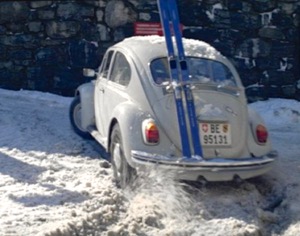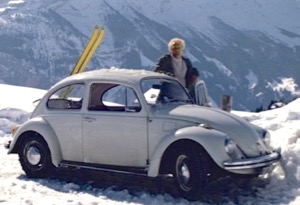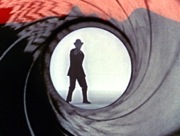by James Kraus

Agent Shaun Campbell climbs the Alps in a VW 1300 shadowing James Bond in a clandestine visit to the headquarters of Ernst Stavro Blofeld
Although one of the most popular and iconic cars of the 1960s, the Volkswagen Beetle did not play a role in a James Bond film until the very end of the decade. In 1969, a VW 1300 is driven in Switzerland by agent Shaun Campbell, Bond’s MI6 backup, in the sixth movie of the series; On Her Majesty’s Secret Service. The Volkswagen is used to trail Bond through the Bernese Oberland en route to Blofeld’s Allergy Clinic. The discreet VW was a wise choice as covert Alpine transport with its generous ground clearance, carefree air-cooling system and rear-engine traction. Although not provided for product placement by Volkswagenwerk AG, the Beetle used was nonetheless the very latest model.
The VW was finished in new-for-1969 Toga White with Gala Red interior and came equipped with optional crank-operated sliding-steel sunroof, padded instrument panel and leatherette upholstery. After the major changes of the previous year (the higher-mounted C-section bumpers, larger tail lamps, flush-mounted headlamps and outside fuel-filler door), the 1969 model-year was one of minor improvements, chiefly the addition of a Porsche-style locking fuel-filler flap with inside release, and remote control levers for the front heating outlets which alleviated the need to bend down to floor level to switch from heat to defrost modes.

James Bond (undercover as Sir Hilary Bray) heads to Blofeld’s lair by sleigh, accompanied by henchwoman Irma Bundt while the pursuing VW awaits
A lesser-noticed change was the elimination of body-coloured running board coverings in favour of black only. Previously, selected colour cars (normally light blue, white and beige) would feature matching or complementary covers, while other colour VWs would make do with black. From 1969 onwards (actually a mid-1968 change), all cars were fitted with black.

Agent Campbell watches as Bond is transferred from sleigh to helicopter. This is the last we see of the VW as agent Campbell must utilize his mountaineering skills from this point forward.
The Beetle’s heyday was the 1960s, and it remained extremely popular even at the end of the decade. European sales were still running strong and deliveries in the U.S. continued to maintain an unbroken upward trajectory, with 1969 setting yet another record; the Beetle responsible for five percent of the American new-car market.
The autumn of 1969 was a pop-culture pinnacle of sorts for the Beetle; just a few months prior to the release of On Her Majesty’s Secret Service, another white VW, in this instance a Lotus White 1968 model, was featured on the cover of what was soon to become the best-selling Beatles album in history, Abbey Road.
By 1969 the Beetle had pretty much evolved into its final form (except for the short-lived 1302 and 1303 Big/Super iterations.) The only remaining exterior visual changes would involve lighting, air intakes and extractors, and minor detailing.
With the exception of the later dual-port 1.6 litre engine and L-Jetronic fuel injection (the latter only in selected markets), the basic Beetle had also reached the peak of its technical specification, offering buyers an array of options including a 1.5 litre engine, front disc brakes, a clutchless gearbox, limited-slip differential and semi-trailing arm rear suspension.
Though agent Campbell failed to survive the duration of the film, VW’s stalwart rear-engined air-cooled Beetle lived on for another ten years in the U.S. market, sixteen years in Europe, and thirty-four years in Mexico. In 1999, the VW was voted 4th overall in the Car of the Century (COTC) award competition; the highest ranking of any 20th Century James Bond literary or cinematic vehicle.

Wonderful piece about one of my favourite Bond films and favourite autos. I had wondered about the color of this VW, whether it Toga White or Chinchilla. Now I know!
I certainly can understand. The two colors are too not far apart, Chinchilla being a very pale grey, and Toga White a very grayish white. In some of the scenes the Beetle does almost appear to be Chinchilla.
I had a 1300cc US model, 1966 was the only year, they went to 1500cc in the US 1967 model.